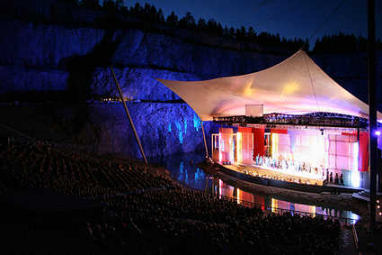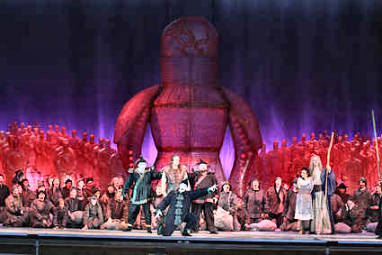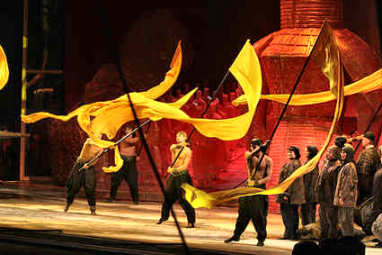Giacomo PUCCINI: Turandot
at Dalhalla, Sweden 5th August, 2005 (GF)
Guest Performance from the Bolshoi
Theatre, Moscow
Conductor and Music Director: Alexander Vedernikov
Director: Francesca Zambello
Designer: Georgy Tsypin
Costumes: Tatyana Noginova
Lighting: Rick Fisher
Choreographer: Andrei Melanin
Chorus Director: Alessandro Pagliazzi
The Emperor Altoum: Alexander
Arkhipov (tenor)
The Princess Turandot, his Daughter: Anna Shafajinskaya (soprano)
Timur, deposed king of Tartary: Vadim Lynkovsky (bass)
Calaf, his son: Oleg Kulko
(tenor)
Liù, the slave girl of Timur: Lolitta Semenina (soprano)
Ping: Nikolai Kazansky (baritone)
Pang: Vyacheslav Voynarovsky (tenor)
Pong: Marat Galiakhmetov (tenor)
Mandarin: Yuri Nechaev (baritone)
The Prince of Persia: Vladimir Danilov
Chorus and Orchestra from the Bolshoi
Theatre
Swedish Children’s Choir/Linda Jansson

The outdoor arena Dalhalla
– the name being a combination of Dalarna,
or Dalecarlia, the province in central Sweden where it is located,
and Wagner’s Valhalla – is a quite remarkable place. It is a
closed down lime-stone quarry in the deep forests a few kilometres
north of Lake Siljan, about 300 kilometres from
Stockholm. In 1991 singer and radio producer Margareta Dellefors discovered its
potentials as a possible festival arena, having tested the acoustics
and being impressed by the sheer size and exterior: oval shaped,
400 metres long, 175 metres wide and 60 metres deep, vertical
rockwalls with terraces, at the bottom
a lake with blue-green water, casting a special spell over the
quarry. Around the arena dark green spruce and pine-trees, lend
an atmosphere of ancient Nordic trolls. After some years of
hectic fund-raising and construction work, Dalhalla
was opened on July 23rd 1994, when legendary Wagnerian
soprano Birgit Nilsson fired the starting shot. Since then a
lot of improvements have been made, step-by-step. Today the
arena seats an audience of around 4000 visitors in the quite
steep amphitheatre; so steep that it allows everyone to see
the action on the stage, placed in the lake, which surrounds
it on three sides. The stage is covered by a gigantic pentagon-shaped
roof. The activities at Dalhalla cover
most musical genres: classical, folk music, choral music, rock,
opera. There have been some internal conflicts concerning the
aim and direction of these activities, and especially Margareta
Dellefors has pleaded for more opera, but in the last resort
financial considerations have to have priority and opera is
seldom a box-office success. The concert season runs from the
beginning of June until the beginning of September, when there
is a Grande Finale with spectacular fireworks. The opera festival
is held in August, but even then the performances have to start
late in the evening, due to the light Nordic summer evenings
which make it impossible to play operas in June and July, since
it never gets really dark then, not even at midnight.
Visiting Dalhalla
is a very special experience indeed and its share of international
visitors is sometimes high. Some years ago, when I heard José
Cura and the Philharmonia Orchestra at Dalhalla,
I happened to sit next to an elderly gentleman who spoke Swedish
with a heavy American accent. When we started talking, it turned
out that he had been born close to Dalhalla
but emigrated to the US in his youth and after that
he had never returned to Sweden, but now he finally had,
since he wanted to, as he put it, “see my arena”. It was his
father no less who started the lime-stone industry there, and
without him there wouldn’t have been a Dalhalla
at all.
A visit there, it should be mentioned,
also requires some preparation for the visitor and some knowledge
about what Swedish summers can sometimes be like. First of all,
having reached the parking lot, there is a 20-minute-walk down
to the arena, along a road that is quite steep and not intended
for high-heeled shoes, which not all visitors realize until
it is too late. Jogging shoes are recommended. Secondly, the
seats, although VIP-lounge comfortable compared to the stone-seats
at the Arena di Verona, need extra
padding, which of course can be bought at the box-office and
thirdly, Swedish summers can
be wonderfully warm even in the evening, but when the damp cold
August air from the surrounding forests creeps down in the quarry
one needs winter equipment. Moreover it happens that the sky
opens and the rain pours down, so a good rain-poncho (which
can also be bought) is a necessity. It is easy to see when arriving
at the parking lot which of the visitors are seasoned Dalhalla enthusiasts. They are carrying large bags with blankets,
cushions, jackets, you name it. If all this sounds discouraging
I can promise you that the experience of being there more than
compensates for the hardship that the visit may involve.

With the
large stage and the fascinating and unique opportunities for
inventive staging that the Dalhalla
arena offers, it is understandable that they choose spectacular
works for the opera festival. This year’s festival has two Puccini
operas, Turandot and Tosca. By some strange coincidence I saw the same two operas on consecutive
evenings in Helsinki a few months ago (see Turandot
review here
and Tosca here)
and some comparisons may be unavoidable.
Turandot was performed by the Bolshoi Theatre of Russia, one of the most renowned opera
companies in the world, on their first ever visit to Sweden. Their own enormous house
in Moscow closed in the end of July for a three-year, £400m
renovation. Accustomed to the large stage of their own house,
the ensemble probably felt quite at home at Dalhalla,
where the stage has about the same dimensions. It also seems
that they were able to transfer the Turandot
sets to Dalhalla with only minor
adjustments. The basic stage picture shows a big, stylized,
featureless torso (well, it has a head) surrounded by a herd
of smaller figures, looking like the fantastic terracotta army,
found and dug out in 1974 in China; the action is set around
200 B.C., the difference being that while Emperor Shi Huangdi’s
soldiers all had individual features, these ones are anonymous
and they are not 6000! On both sides of the stage there are
movable screens in different colours, with which it is possible
to change the picture, completely hide the back of the stage
etc. The lighting plays an important part of the staging and
during the first act the daylight, since this was a clear evening,
was still so dominant that the stage lights were more or less
outdone.
The very first chords of the orchestra
at once made it clear to first time visitors that the Dalhalla
acoustics are not just a myth. It is a clear, almost analytical
sound with enough space around it to give it body and punch.
It is a surprisingly forward sound, considering the outdoor
surroundings, where in Verona’s vast arena the sound picture
is recessed and quite dim – unless you can afford to buy tickets
for the front stalls. These chords also confirmed that this
orchestra is world-class. It is a lean sound, lean but not weak
and the precision was impressive, the brass menacing and imposing.
Conductor Alexander Vedernikov, not to be confused with the likewise named bass
singer, who once was a great name at Bolshoi,
had a firm grip of the proceedings and kept the drama moving
on. The chorus, quite as important as any of the protagonists
in this opera, was also magnificent, powerful and incisive and
with none of the Slavonic wobble that has sometimes marred East
European performances, at least on records. There were also
spectacular contributions from the ballet, e.g. in the second
act celebrations of the Emperor with enormous yellow flags filling
the stage. Over all the mass-scenes were skilfully handled,
juxtaposing the different groupings of the people, with contrastingly
coloured costumes. I have to say, though, that compared to the
Helsinki production, the first act beheading of the Prince of
Persia, which luckily takes place off-stage, passed by rather
unnoticed and the long, maybe overlong, scene beginning Act
II with Ping, Pang and Pong felt a little static and bloodless,
in spite of good singing and acting. There Helsinki managed to put life into
the proceeding by employing three mimers
who were a kind of projection of the three ministers.

Dalhalla also invites unconventional
stage solutions, sometimes out of necessity – there is for example
no curtain – and in this performance they made inventive use
of the lake, separating the stage from the audience at the beginning
of Act III. By then, despite the cloudless sky only pierced
by the odd, twinkling star, it was almost pitch-black in the
arena and it was really effective to have two rowing-boats with
torches searching the water, while on stage actors with torches
also searched... for what? Of course, the identity of the unknown
prince. Under the threat of being killed if nobody could come
up with his name, nobody is allowed to sleep (Nessun dorma). Terror and abuse of power is something that runs
all through history, connecting our time with the Empire of
China more than 2000 years ago. This opera is also highly modern,
or rather timeless, in so far as it illustrates how people under
pressure and threat react.
But the real message of this opera,
in spite of all the cruelty that is displayed, is after all
that love is stronger than hate, that blood is warmer than ice.
When at the very end of the opera Calaf’s love defeats Turandot’s
ice, she sings Odi! Squillan le trombe! (Sound the trumpets!), and the trumpets are sounded,
not from the orchestral pit though, but from a shelf on the
vertical wall of Dalhalla, high above
the stage, high above the audience, again illuminated by torches.
A brilliant stroke of genius. A more conventional but highly
illuminating piece of staging is in the scene with the three
riddles. Every correct answer is marked with flashing jackpot
lights.
There is a now a new generation
of singers at the Bolshoi, having taken over after the Golden age names like
Vishnevskaya, Atlantov, Arkhipova and Nesterenko, to name
but a few. But still there is the odd veteran, like Alexander
Arkhipov as the Emperor, who sounded just as old as he is
supposed to be and gave a really moving portrait of Altoum.
The three ministers, Ping, Pang and Pong, always have their
curtain calls as a trio, and they were good but Nikolai Kazansky
as Ping was head and shoulders above the others, especially
vocally. He exhibited a fine, expressive baritone and it was
no surprise to read in the programme booklet that he has been
a successful Mozart Figaro. A fine stage presence. Vadim Lynkovsky, singing Timur, was vocally perhaps the most impressive of all the
soloists: a big, sonorous, warm bass voice. Just as with his
counterpart in Helsinki I wish the part had been much bigger.
His slave girl, Liù, was sung by Lolitta Semenina. She could be a little hard in tone with a trace
of wobble in her basically very beautiful voice, but she sang
a very inward Signore, ascolta in
the first act and her death scene was likewise finely nuanced
but also done with great intensity. Oleg Kulko
has had quite an extensive international career with appearances
at the Metropolitan and Washington operas recently. He has a
fairly large-sized tenor, and he was a straightforward Calaf,
singing with heroic tone in the second act riddle scene and
delivering a fine Nessun dorma. Turandot
herself, Anna Shafajinskaya, Ukrainian
and Canadian citizen and frequent guest in many of the big opera
houses worldwide, has been heard in this part at both Covent
Garden and the ENO. The first impression was of a thick-voiced,
almost contraltoish singer but she
soon showed other qualities and she could float a hushed pianissimo
to good effect, which not every Turandot can manage. It is a
big, strong voice that no orchestra in the world can drench
and she was untiring through the performance of this devillishly
high-lying part. When, after Calaf had given the correct answer
to her third riddle, she pleads to her father not to give her
away to this stranger, she suddenly adopts a much smaller, lyric
voice with much more warmth. But when she sings “No man will
ever get me” she is again the icy princess. In the last act,
while trying to force Liù to reveal
the name of the unknown prince, she asks: how can you be so
strong? And Liù answers: It’s love.
Then again some of her ice melts and she becomes a human. She
impressed greatly.
In a nutshell, then: a splendid
staging, wonderful playing by the orchestra and with impressive
vocal performances. And even if we towards the end of the opera,
near midnight, felt just as icy as Turandot’s heart, when love finally triumphed our hearts also
warmed.
Göran Forsling
Photographs © Martin Litens 2005





